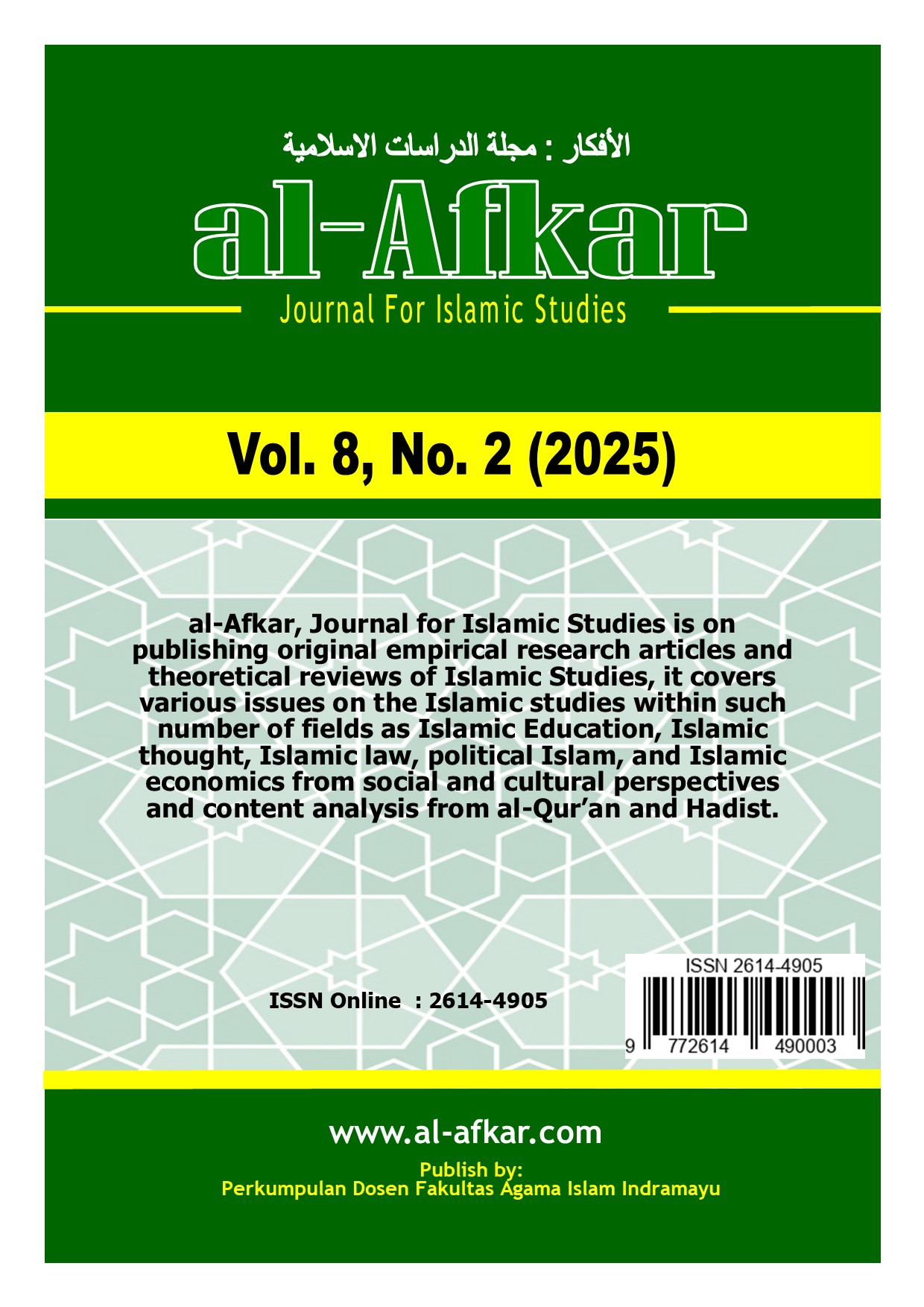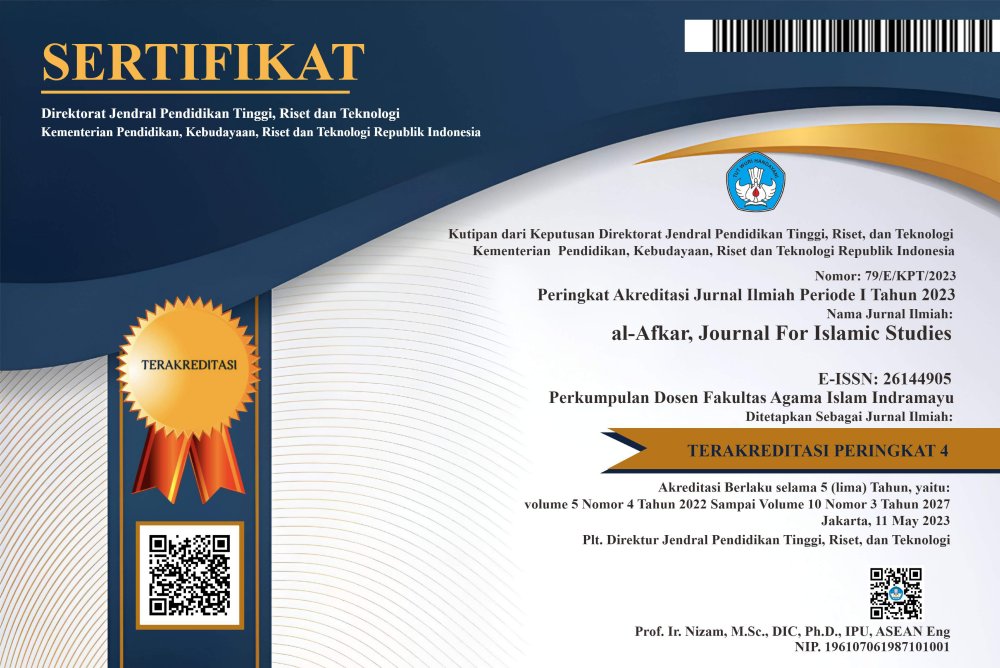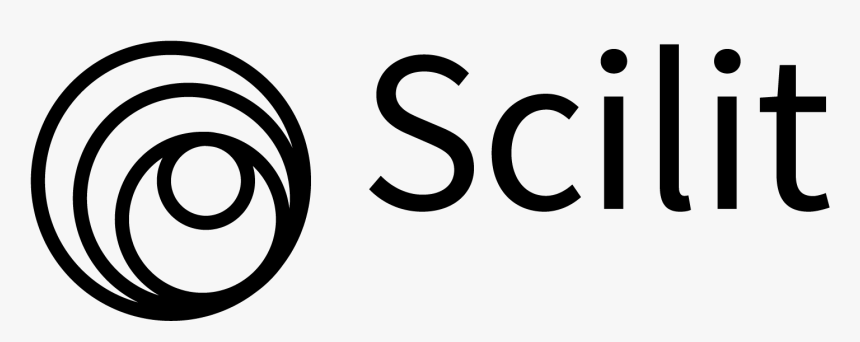The Shifting Value of Veil on Muslim Women and the Impact of Modernization
DOI:
https://doi.org/10.31943/afkarjournal.v8i2.1396Keywords:
Veil, Muslim Women, Modernization, TrendAbstract
Veil is a symbol of religious obedience for Muslim women. That is what continues to be believed until the occurrence of modernization which causes a value shift in the scope of the meaning of the veil. This article focuses on the scope of the veil which has become the lifestyle of Muslim women today. The approach used in this research is qualitative by conducting field studies in the form of observations around the Sleman area, Yogyakarta to observe Muslim women who use the veil with various models and types. In addition, this article also uses previous research as a foundation in research and to collect the data needed. After obtaining the data sought, data analysis is then carried out which is divided into three, namely data reduction, data presentation, and finally data verification on conclusion drawing. The result obtained is that modernization has a positive and negative impact on the veil users. The advantage is the progress in thinking of women who wear the veil so that they are not confined to the authority of men, while the disadvantage is the erosion of religious values from the use of veil which should have the main function to cover the intimate part (aurat) and curves of the female body and maintain women’s honor into a trend due to the influence of modernization. nevertheless, this article does not blame any hijab models used in daily life. Of course it goes back to the rights of each individual.
Downloads
References
Asry, Lenawati. “Modernisasi Dalam Perspektif Islam. Jurnal Ilmiah Prodi Komunikasi Dan Penyairan Islam.” Jurnal Ilmiah Prodi Komunikasi Dan Penyairan Islam 2, no. 10 (2019): 126–36.
Baehr, Peter. “The Image of the Veil in Social Theory.” Theory and Society 48, no. 4 (2019): 535–58. https://doi.org/10.1007/s11186-019-09357-1.
Budiati, Atik Catur. “Jilbab: Gaya Hidup Baru Kaum Hawa.” Sosiologi Islam 1, no. 1 (2011): 59–70.
Burke, Peter. Sejarah Dan Teori Sosial. Edited by Mestika Zed, Zulfami, and A. Sairozi. Revista Brasileira de Linguística Aplicada. 2nd ed. Vol. 5. Jakarta: Yayasan Pustaka Obor Indonesia, 2015.
Fitry, Adheyatul. “Jilbab Sebagai Ibadah.” DIKTUM: Jurnal Syariah Dan Hukum 17, no. 1 (2019): 87–101. http://repositorio.unan.edu.ni/2986/1/5624.pdf%0Ahttp://fiskal.kemenkeu.go.id/ejournal%0Ahttp://dx.doi.org/10.1016/j.cirp.2016.06.001%0Ahttp://dx.doi.org/10.1016/j.powtec.2016.12.055%0Ahttps://doi.org/10.1016/j.ijfatigue.2019.02.006%0Ahttps://doi.org/10.1.
Gökarıksel, Banu, and Anna Secor. “The Veil, Desire, and the Gaze: Turning the Inside Out” 40, no. 1 (2014): 177–200.
Hartini, Dwi. “PAKAIAN SEBAGAI GEJALA MODERNITAS (Kajian Surat Al-Ahzab Ayat 59 Dan Surat Al-Nur Ayat 31).” Jurnal At-Tibyan: Jurnal Ilmu Alquran Dan Tafsir 4, no. 1 (2019): 26–44. https://doi.org/10.32505/tibyan.v4i1.858.
Husaeni, Moh. “Fenomena Jilboobs Di Kalangan Remaja.” Institut PTIQ Jakarta, 2023.
Lutfiah, Winona, Esya Heryana, Fitriani Fitriani, Raihan Raihan, and Ruslan Sangaji. “Interpretasi Ayat-Ayat Tentang Jilbab: Studi Perbandingan Terhadap Musṭafa Al-Marāgî Dan Hamka.” Jurnal Riset Agama 1, no. 3 (2021): 170–87. https://doi.org/10.15575/jra.v1i3.15114.
Maula, Nina Inayatul. “Penafsiran Imad Zaki Al-Barudi Tentang Berjilbab Bagi Perempuan Dalam Islam (Analisa Terhadap Ayat-Ayat Tentang Berjilbab Dalam Tafsir Al-Qur’an Wanita Karya Imad Zaki Al-Barudi).” Jurnal Riset Agama 2, no. 1 (2022): 181–99. https://doi.org/10.15575/jra.v2i1.17123.
Maulina, Putri, Ainal Fitri, and Dony Arung Triantoro. “Narasi Jilbab Dan Realitas Simulakra Di Akun Instagram @buttonscarves.” Jurnal Komunikasi Global 12, no. 1 (2023): 1–29. https://doi.org/10.24815/jkg.v12i1.31232.
Munawarotul Hasanah, Mumun, Pirda Raudatul Jannah, Rabbani Pasha Ababyl, and Rafi Daffa Musyaffa. “Islam, Cadar, Jilbab Dan Burqa Dalam Al-Qur’an.” Nusantara Hasana Journal 3, no. 2 (2023): 16–21. https://doi.org/10.59003/nhj.v3i2.910.
Nisa, Khairun, and Rudianto. “TREND FASHION HIJAB TERHADAP KONSEP DIRI.” Interaksi 1, no. 3 (2017): 105–17.
Nurdianik, Yulia, Siti Gomo Attas, and Miftahul Kahairah Anwar. “Hijab: Antara Tren Dan Syariat Di Era Kontemporer.” Indonesian Journal of Social Science Review 1, no. 1 (2022): 19.
Rohim, Ainur. “Jilbab Antara Orisinalitas Dan Produk Budaya.” JUPE : Jurnal Pendidikan Mandala 7, no. 2 (2022): 418–32. https://doi.org/10.58258/jupe.v7i2.3524.
Rohmaniyah, Naila, Ris’an Rusli, Amilda Sani, and Agus Sholikhin. “Jilbab: Ajaran Agama, Budaya Dan Peradaban.” Cakrawala: Jurnal Studi Islam 18, no. 1 (2023): 49–61. https://doi.org/10.31603/cakrawala.8513.
Seedat, Fatima, and Anna King. Feminisme, Islam, Dan Islam Feminis. OSIRIS, n.d.
Shihab, M. Quraish. Jilbab, Pakaian Wanita Muslimah. VI. Jakarta: Lentera Hati, 2012.
Sukendro, Gatot, Achmad Haldani Destiarman, and Kahfiati Kahdar. “Nilai Fetisisme Komoditas Gaya Hijab (Kerudung Dan Jilbab) Dalam Busana Muslimah.” Jurnal Sosioteknologi 15, no. 2 (2016): 241–54. https://doi.org/10.5614/sostek.itbj.2016.15.02.7.
Tawakalni, Annisa, Radea Yuli Ahmad Hambali, and Ahmad Gibson Albustomi. “Konsep Hijab Menurut Murtadha Muthahhari Dan Relevansinya Dengan Persoalan Etis Dan Teologis.” Jurnal Riset Agama 2, no. 3 (2022): 1–18. https://doi.org/10.15575/jra.v2i3.18302.
Ubaidillah, Asep. “Pembiasaan Jilbab Pada Anak Usia Dini Dan Relevansinya Dalam Penerapan Nilai-Nilai Syariat Islam.” El-Athfal : Jurnal Kajian Ilmu Pendidikan Anak 1, no. 01 (2021): 33–45. https://doi.org/10.56872/elathfal.v1i01.272.
Wahidar, Tutut Ismi. “Perilaku Komunikasi Pengguna Jilboobs Dalam Pembentukan Identitas Diri : Studi Komparatif Pada Mahasiswi Universitas Muhammadiyah Sumatera Utara Dan Universitas Islam Sumatera Utara Medan.” Simbolika 2 (2016).
Wijayanti, Ratna. “Jilbab Sebagai Etika Busana Muslimah Dalam Perspektif Al-Qur’an.” CAKRAWALA: Jurnal Studi Islam 12, no. 2 (2017): 151–70.
Yulcin, Mahmud. “Jilbab Sebagai Gaya Hidup Wanita Modern Di Kalangan Mahasiswi Fakultas Ilmu Sosial Dan Politik Universitas Sam Ratulangi.” Jurnal Holistik 13, no. 3 (2020): 1–14.
Yulikhah, Safitri. “Jilbab Antara Kesalehan Dan Fenomena Sosial.” Jurnal Ilmu Dakwah 36, no. 1 (2017): 96. https://doi.org/10.21580/jid.v36i1.1627.
Yuliza, Lini. “Trend Berpakaian Masa Kini Mengubah Fungsi Busana Muslimah Di Kalangan Wanita Muslim.” GUaU Jurnal Pendidikan Profesi Guru Agama Islam 1, no. 1 (2021): 11–22.
Yusmawati, Yusmawati, and Restiawan Permana. “Konstruksi Pesan Dan Pemaknaan Visual Dalam Video Marketing Campaign ‘Nike Pro Hijab’ Dan ‘Noore Sport Hijab.’” Jurnal Komunika Islamika : Jurnal Ilmu Komunikasi Dan Kajian Islam 8, no. 1 (2021): 10. https://doi.org/10.37064/jki.v8i1.9477.
Zahedi, Ashraf. “Contested Meaning of the Veil and Political Ideologies of Iranian Regimes.” Journal of Middle East Women’s Studies 3, no. 3 (2007): 75–98. http://digilib.unila.ac.id/4949/15/BAB II.pdf.
Downloads
Published
How to Cite
Issue
Section
License
Copyright (c) 2025 Rahmi, Ita Rodiah

This work is licensed under a Creative Commons Attribution 4.0 International License.



















